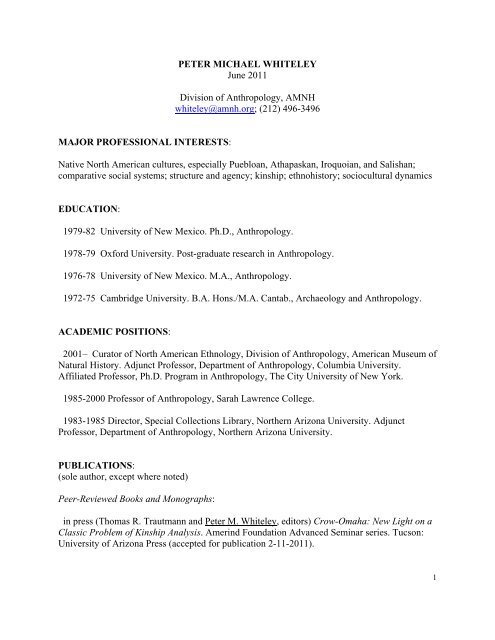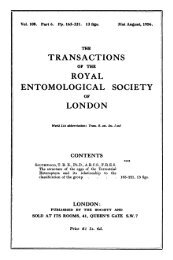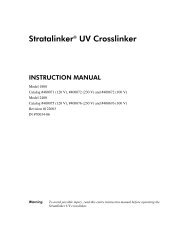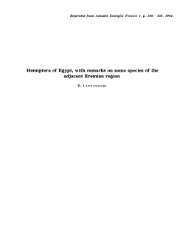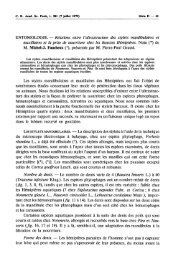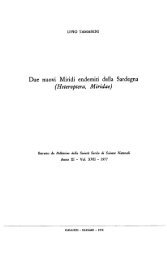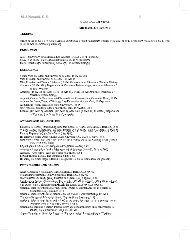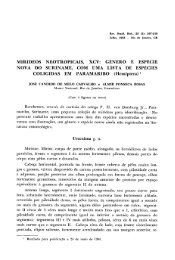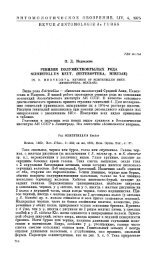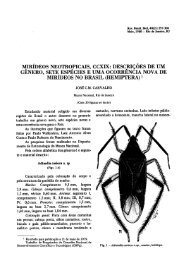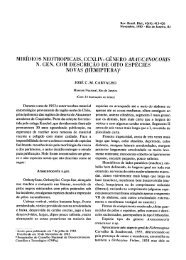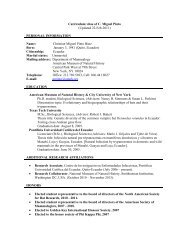peter michael whiteley - AMNH Research Sites - American Museum ...
peter michael whiteley - AMNH Research Sites - American Museum ...
peter michael whiteley - AMNH Research Sites - American Museum ...
Create successful ePaper yourself
Turn your PDF publications into a flip-book with our unique Google optimized e-Paper software.
MAJOR PROFESSIONAL INTERESTS:<br />
PETER MICHAEL WHITELEY<br />
June 2011<br />
Division of Anthropology, <strong>AMNH</strong><br />
<strong>whiteley</strong>@amnh.org; (212) 496-3496<br />
Native North <strong>American</strong> cultures, especially Puebloan, Athapaskan, Iroquoian, and Salishan;<br />
comparative social systems; structure and agency; kinship; ethnohistory; sociocultural dynamics<br />
EDUCATION:<br />
1979-82 University of New Mexico. Ph.D., Anthropology.<br />
1978-79 Oxford University. Post-graduate research in Anthropology.<br />
1976-78 University of New Mexico. M.A., Anthropology.<br />
1972-75 Cambridge University. B.A. Hons./M.A. Cantab., Archaeology and Anthropology.<br />
ACADEMIC POSITIONS:<br />
2001– Curator of North <strong>American</strong> Ethnology, Division of Anthropology, <strong>American</strong> <strong>Museum</strong> of<br />
Natural History. Adjunct Professor, Department of Anthropology, Columbia University.<br />
Affiliated Professor, Ph.D. Program in Anthropology, The City University of New York.<br />
1985-2000 Professor of Anthropology, Sarah Lawrence College.<br />
1983-1985 Director, Special Collections Library, Northern Arizona University. Adjunct<br />
Professor, Department of Anthropology, Northern Arizona University.<br />
PUBLICATIONS:<br />
(sole author, except where noted)<br />
Peer-Reviewed Books and Monographs:<br />
in press (Thomas R. Trautmann and Peter M. Whiteley, editors) Crow-Omaha: New Light on a<br />
Classic Problem of Kinship Analysis. Amerind Foundation Advanced Seminar series. Tucson:<br />
University of Arizona Press (accepted for publication 2-11-2011).<br />
1
PUBLICATIONS (Peer-Reviewed Books and Monographs, cont.):<br />
2008 The Orayvi Split: A Hopi Transformation. Anthropological Papers of the <strong>American</strong><br />
<strong>Museum</strong> of Natural History 87. 2 vols.<br />
1998 Rethinking Hopi Ethnography. Washington, DC: Smithsonian Institution Press.<br />
1989 (Klara B. Kelley and Peter M. Whiteley) Navajoland: Family Settlement and Land Use.<br />
Tsaile, AZ: Navajo Community College Press.<br />
1988 Deliberate Acts: Changing Hopi Culture through the Oraibi Split. Tucson: University of<br />
Arizona Press.<br />
Non-Peer-Reviewed Books:<br />
1988 Bacavi: Journey to Reed Springs. Flagstaff, AZ: Northland Press.<br />
Peer-Reviewed Articles and Chapters:<br />
in review:<br />
a. Chacoan Kinship. In Current Issues in the Archaeology of Chaco Canyon, A.D. 850-1150,<br />
edited by Stephen Plog and Caroline Heitman. Tucson: University of Arizona Press.<br />
b. Hopitutskwa, the Traditional Hopi Land Claim. In Ethics, Poetics, and Aesthetics among the<br />
Hopi: Essays in Honor of Emory Sekaquaptewa, Justin B. Richland, ed.<br />
in press:<br />
a. Crow-Omaha Kinship in North America: A Puebloan Perspective. In Crow-Omaha: New<br />
Light on a Classic Problem of Kinship Analysis, edited by Thomas R. Trautmann and Peter M.<br />
Whiteley. Tucson: University of Arizona Press (accepted for publication 2-11-2011).<br />
b. (Ward C. Wheeler, Peter M. Whiteley, and Theodore Powers) Phylogenetic Analysis of<br />
Socio-Cultural Data: Identifying Transformation Vectors for Kinship Systems. In Crow-Omaha:<br />
New Light on a Classic Problem of Kinship Analysis, edited by Thomas R. Trautmann and Peter<br />
M. Whiteley. Tucson: University of Arizona Press (accepted for publication 2-11-2011).<br />
c. Thomas R. Trautmann and Peter M. Whiteley, Introduction: A Classic Problem. In<br />
Crow-Omaha: New Light on a Classic Problem of Kinship Analysis, edited by Thomas R.<br />
Trautmann and Peter M. Whiteley. Tucson: University of Arizona Press (accepted for<br />
publication 2-11-2011).<br />
2
PUBLICATIONS (Peer-Reviewed Articles and Chapters, cont.):<br />
in press:<br />
d. Thomas R. Trautmann and Peter M. Whiteley, Afterword: Crow-Omaha, in Thickness and in<br />
Thin. In Crow-Omaha: New Light on a Classic Problem of Kinship Analysis, edited by Thomas<br />
R. Trautmann and Peter M. Whiteley. Tucson: University of Arizona Press (accepted for<br />
publication 2-11-2011).<br />
e. Turquoise and Squash Blossom: A Pueblo Dialogue of the Long Run. British <strong>Museum</strong><br />
Proceedings (accepted for publication 1-5-2011).<br />
f. Epilog: Prolegomenon for a New Totemism. In Extinction Encounters: Dying Forms and the<br />
Ethics of Retrieval, edited by Genese M. Sodikoff. Bloomington: Indiana University Press<br />
(accepted for publication, December 2010).<br />
g. Yukiwmat Navoti’at: The Tradition of Yukiwma. In Inside Dazzling Mountains:<br />
Contemporary Translations of Southwest Native Verbal Arts. David Kozak, ed. Lincoln:<br />
University of Nebraska Press (scheduled for publication spring 2012).<br />
h. Who Were the Napac? Decoding an Ethnohistorical Enigma. Kiva: The Journal of<br />
Southwestern Anthropology and History (scheduled for publication fall 2011).<br />
2011 Hopi Place Value: Translating a Landscape. In Born in the Blood: On Native <strong>American</strong><br />
Translation, Brian Swann, ed., pp 84-108. Lincoln: University of Nebraska Press.<br />
2009 Losing the Names: Native Languages, Identity, and the State. In Language and Poverty,<br />
Wayne Harbert, Sally McConnell-Ginet, Amanda Miller, and John Whitman, editors, pp. 161-<br />
179. Clevedon, UK: Multilingual Matters.<br />
2008 Explanation vs. Sensation: the Discourse of Cannibalism at Awat’ovi. In Social Violence<br />
in the Prehispanic <strong>American</strong> Southwest, Deborah Nichols and Patricia Crown, eds., pp. 184-215.<br />
Tucson: University of Arizona Press.<br />
2004 Why Anthropology Needs More History. Journal of Anthropological <strong>Research</strong><br />
Distinguished Lecture. Journal of Anthropological <strong>Research</strong> 60:4:487-514.<br />
2004 Social Formations in the Pueblo IV Southwest: an Ethnological View. In The<br />
Protohistoric Pueblo World, A.D. 1275-1600, E. Charles Adams and Andrew Duff., eds., pp.<br />
144-155. Tucson: University of Arizona Press.<br />
2004 Bartering Pahos with the President. Ethnohistory 51:2:359-414.<br />
3
PUBLICATIONS (Peer-Reviewed Articles and Chapters, cont.):<br />
2003 Do “Language Rights” Serve Indigenous Interests? Some Hopi and Other Queries.<br />
<strong>American</strong> Anthropologist 105:4:712-722.<br />
2003 Reconnoitering “Pueblo” Ethnicity: the 1852 Tesuque Delegation to Washington. Journal<br />
of the Southwest 45:3:437-518.<br />
2003 Leslie White’s Hopi Ethnography: Of Practice and in Theory. Journal of Anthropological<br />
<strong>Research</strong> 59:2:151-81.<br />
2002 Archaeology and Oral Tradition: the Scientific Importance of Dialogue. Forum article in<br />
<strong>American</strong> Antiquity 67:3:405-415.<br />
2002 Re-imagining Awat’ovi. In Archaeologies of the Pueblo Revolt: Identity, Meaning, and<br />
Renewal in the Pueblo World, Robert Preucel, ed., pp. 147-65. Albuquerque: University of New<br />
Mexico Press.<br />
1998 (Peter M. Whiteley and Vernon Masayesva) The Use and Abuse of Aquifers: Can the<br />
Hopi Indians Survive Multinational Mining? In Water, Culture, and Power: Local Struggles in a<br />
Global Context, John M. Donahue and Barbara Rose Johnston, eds., 9-34. Washington, DC:<br />
Island Press.<br />
1997 The End of Anthropology (at Hopi)? In Indians and Anthropologists: Vine Deloria, Jr.,<br />
and the Critique of Anthropology, Thomas Biolsi and Larry Zimmerman, eds.,177-207. Tucson:<br />
University of Arizona Press. (Revision of 1993 version).<br />
1993 The End of Anthropology (at Hopi)? Journal of the Southwest 35:2:125-157.<br />
1992 Hopitutungwni: ‘Hopi Names’ as Literature. In On the Translation of Native <strong>American</strong><br />
Literatures, Brian Swann, ed., pp. 208-227. Washington, DC: Smithsonian Institution Press.<br />
1992 Burning Culture: Auto-da-fé at Oraibi. History and Anthropology 6:1:46-85.<br />
1990 Land Availability and the Oraibi Split: A Rejoinder to Levy. <strong>American</strong> Anthropologist<br />
92:3:743-44.<br />
1989 Can Anthropologists Be Neutral in Land Disputes? The Hopi-Navajo Case. MAN (n.s.)<br />
24:340-41.<br />
1987 The Interpretation of Politics: a Hopi Conundrum. MAN (n.s.) 22:696-714. (Reprinted in<br />
Across the Boundaries of Belief: Contemporary Issues in the Anthropology of Religion, 1999,<br />
Morton Klass and Maxine Weisgrau, editors, pp. 303-23. Boulder, CO: Westview Press.)<br />
1986 Unpacking Hopi “Clans,” II: Further Questions about Hopi Descent Groups. Journal of<br />
Anthropological <strong>Research</strong> 42:69-79.<br />
4
PUBLICATIONS (Peer-Reviewed Articles and Chapters, cont.):<br />
1985 Unpacking Hopi “Clans”: Another Vintage Model out of Africa? Journal of<br />
Anthropological <strong>Research</strong> 41:359-74.<br />
1985 Ceremony and Politics: Towards a Model of Power among the Hopi. Proceedings of the<br />
International Congress of <strong>American</strong>ists (Identidad y Transformacion de las Americas) 45:2:172-<br />
92. Bogotá, Colombia: Ediciones Uniandes.<br />
Non-Peer-Reviewed Articles:<br />
2008 (authors: Andrew J. Duff, T. J. Ferguson, Susan Bruning, and Peter Whiteley).<br />
Collaborative <strong>Research</strong> in a Living Landscape: Pueblo Land, Culture, and History in West-<br />
Central New Mexico. Archaeology Southwest 22:1.<br />
2007 Foreword in Edward P. Dozier: the Paradox of the <strong>American</strong> Indian Anthropologist by<br />
Marilyn Norcini. Tucson: University of Arizona Press.<br />
2004 The Hopi Gift Economy. Natural History 113:9:26-31.<br />
2004 Ethnography. In A Companion to the Anthropology of <strong>American</strong> Indians, Thomas Biolsi,<br />
ed., pp. 435-471. Malden, MA: Blackwell.<br />
2004 Contributing editor, Totems to Turquoise: Native North <strong>American</strong> Jewelry Arts of the<br />
Northwest and Southwest (volume accompanying the exhibit), Kari Chalker, ed. Two articles:<br />
‘Curators’ Introduction: Jewelry as a Visual Language’ (with Lois S. Dubin), pp. 16-27; and<br />
‘The Southwest Painterly Style and its Cultural Context,’ pp. 148-56. New York: Abrams.<br />
2001 Hopi Histories. In Katsina: Commodified and Appropriated Images of Hopi<br />
Supernaturals, Zena Pearlstone, ed., pp. 22-33. Los Angeles: Fowler <strong>Museum</strong> of Cultural<br />
History, University of California.<br />
1999 Alfonso Ortiz, 1939-1997. <strong>American</strong> Anthropologist 101:2:392-95.<br />
1999 (with Vernon Masayesva) Paavahu and Paanaqso’a: the Wellsprings of Life and<br />
the Slurry of Death. In Cultural and Spiritual Values of Biodiversity, Darrell A. Posey, ed., 403-<br />
06. United Nations Environment Programme. London: Intermediate Technology Publications.<br />
1999 Can (Pre-)histories Converge? Meaning, Truth and Value in the Western Pueblo Past.<br />
Proceedings of the Affiliation Conference on Ancestral Peoples of the Four Corners Region, vol.<br />
2, Philip Duke, ed.. Fort Lewis College and the National Park Service. Durango, CO.<br />
1998 Native <strong>American</strong> Philosophy. In Routledge Encyclopedia of Philosophy, Edward Craig,<br />
ed, vol. 6:662-72. New York: Routledge.<br />
5
PUBLICATIONS (Non-Peer-Reviewed Articles, cont.):<br />
1996 Paavahu and Paanaqawu: The Wellsprings of Life and the Slurry of Death. Cultural<br />
Survival Quarterly Special Issue on <strong>American</strong> Indian Religious Freedom, Alfonso Ortiz, ed.,<br />
19:4:40-45.<br />
1989 Southwest Indian Religions. In Native <strong>American</strong> Religions: North America, Lawrence E.<br />
Sullivan, ed., 45-64. New York: MacMillan.<br />
1984 Apropos the Nova film “Anthropology on Trial.” Anthropology Newsletter 25:2:2.<br />
Reviews and Abstracts:<br />
2011 William Fenton: Selected Writings, by William N. Fenton. Edited and with an<br />
introduction by William A. Starna and Jack Campisi (University of Nebraska Press, 2009).<br />
Journal of Anthropological <strong>Research</strong> 67:1:142-143.<br />
2008 Hopi Oral Tradition and the Archaeology of Identity, by Wesley Bernardini (University of<br />
Arizona Press, 2005). <strong>American</strong> Antiquity 73:3:574-75.<br />
2007 Abstract for “Bilaterality and Unilineality in Western Pueblo Social Structure,” Society<br />
for <strong>American</strong> Archaeology annual meeting program, Austin, TX.<br />
2006 Abstract for “When is a Ki’yta? Houses and Lineages in Hopi Social Structure,”<br />
International Congress of <strong>American</strong>ists symposium program, Seville, Spain.<br />
2004 Hopi Animal Stories, Ekkehart Malotki, ed., narrated by Michael Lomatuway’ma and<br />
Sidney Namingha, Jr. introduced by Barre Toelken (University of Nebraska Press, 2001); and<br />
Hopi Stories of Witchcraft, Shamanism, and Magic, by Ekkehart Malotki and Ken Gary<br />
(University of Nebraska Press, 2001). New Mexico Historical Review 79:3:420-24.<br />
2000 Pueblo Profiles: Cultural Identity through Centuries of Change, by Joe Sando (Clear Light<br />
Press, 1998). <strong>American</strong> Indian Culture and <strong>Research</strong> Journal 24:2:195-199.<br />
1999 Hopi Dictionary/Hopìikwa Lavàytutuveni: a Hopi-English Dictionary of the Third Mesa<br />
Dialect, by The Hopi Dictionary Project (University of Arizona Press, 1997). <strong>American</strong><br />
Anthropologist 101:3:659-660.<br />
1997 The Navajo-Hopi Land Dispute: an <strong>American</strong> Tragedy, by David M. Brugge (University<br />
of New Mexico Press, 1994). Ethnohistory 44:2:412-415.<br />
1996 Kachinas in the Pueblo World, Polly Schaafsma, ed. (University of New Mexico Press,<br />
1994). <strong>American</strong> Anthropologist 98:1:178-180.<br />
6
PUBLICATIONS (Reviews and Abstracts, cont.):<br />
1995 Lumbee Indian Histories: Race, Ethnicity, and Indian Identity in the Southern United<br />
States, by Gerald M. Sider (Cambridge University Press, 1993). <strong>American</strong> Anthropologist<br />
97:4:817-818.<br />
1994 Orayvi Revisited: Social Stratification in an “Egalitarian” Society, by Jerrold E. Levy<br />
(School of <strong>American</strong> <strong>Research</strong> Press, 1992). Anthropos 89:1/3:286-287.<br />
1994 Born a Chief: The Nineteenth Century Hopi Boyhood of Edmund Nequatewa, P. David<br />
Seaman, ed. (University of Arizona Press, 1993). Ethnohistory 41:3:478-480.<br />
1994 Hopi Ruin Legends-Kiqötutuwutsi, Ekkehart Malotki, ed., narrated by Michael<br />
Lomatuway’ma, Lorena Lomatuway’ma, and Sidney Namingha, Jr. (University of Nebraska<br />
Press, 1993). <strong>American</strong> Anthropologist 96:4:996-997.<br />
1993 Religion and Hopi Life in the Twentieth Century, by John D. Loftin (Indiana University<br />
Press, 1991); and Seasons of the Kachina: Proceedings of the California State, Hayward,<br />
Conference on the Western Pueblos, 1987-1988, Lowell J. Bean, ed. (Ballena Press, 1989).<br />
Ethnohistory 40:1:123-126.<br />
1992 Designs and Factions: Politics, Religion and Ceramics on the Hopi Third Mesa, by Lydia<br />
L. Wyckoff (University of New Mexico Press, 1990). <strong>American</strong> Ethnologist 19:4:833-834<br />
1992 The Origin and Development of the Pueblo Katsina Cult, by E. Charles Adams<br />
(University of Arizona Press, 1991). New Mexico Historical Review 67:4:421-422.<br />
1990 Dwellers at the Source: Southwestern Indian Photographs of A.C. Vroman, 1895-1904, by<br />
William Webb and Robert A. Weinstein (University of New Mexico Press, 1987); and The Hopi<br />
Photographs, Kate Cory: 1905-1912 (University of New Mexico Press, 1986). <strong>American</strong> Indian<br />
Quarterly 14:3:325-326.<br />
1989 Hopi: Songs of the Fourth World, directed by Pat Ferrero (New Day Films, 1984).<br />
1982 Historic Hopi Ceramics: The Thomas V. Keam Collection of the Peabody <strong>Museum</strong> of<br />
Archaeology and Ethnology, Harvard University, by Edwin L. Wade and Lea S. McChesney<br />
(Peabody <strong>Museum</strong> Press, 1981). Journal of Anthropological <strong>Research</strong> 38:1:129-130.<br />
7
RESEARCH:<br />
Ethnographic:<br />
2011 Field trip to Hopi Reservation, AZ. Focus on ethnogeography.<br />
2010 Two field trips to Sauk-Suiattle Reservation, WA. Focus on ethnohistory.<br />
2010 Field trip to Huron-Wendat Reserve, QE. Focus on ethnohistory.<br />
2009 Two field trips to Sauk-Suiattle Reservation, WA. Focus on ethnohistory.<br />
2009 Two field trips to Hopi Reservation, AZ. Focus on: 1) ethnohistory; 2) ethnogeography.<br />
2009 Kahnawake Reserve, QE. Focus on ethnohistory.<br />
2008 Two field trips to Hopi Reservation, AZ. Focus on ethnogeography and resource uses.<br />
2008 Field trip to Santo Domingo Pueblo, NM. Focus on contemporary Pueblo ritual and<br />
linguistic persistence.<br />
2008 Field trip to PII and PIII ruins in Chaco Canyon, and Aztec National Monument. With<br />
Stephen Plog and University of Virginia field school. Focus on Puebloan prehistory.<br />
2006 Field trip to Akwesasne Mohawk Reservation, NY/ON/QE. Focus on ethnohistory,<br />
persistence and change.<br />
2006 Field trip to Zuni Salt Lake and vicinity, NM, with Hopi elders. Focus on ritual<br />
and ethnogeography.<br />
2005 Field trip to Hopi Reservation, AZ. Focus on social structure and ethnohistory.<br />
2004 Field trip to Hopi Reservation, AZ. Focus on traditional resource uses.<br />
2004 Field trip to Cayuga Nation, NY. Focus on sociocultural persistence and change.<br />
2003 Two field trips to Hopi Reservation, AZ. Foci on ethnohistory and resource uses.<br />
2002 Field trip to Six Nations Reserve, ON, and Cayuga Nation, NY. Focus on sociocultural<br />
persistence and change.<br />
2002 Field trip to Hopi Reservation, AZ, and Zuni, Laguna, and Tesuque Pueblos, NM. Focus<br />
on (Hopi): ethnohistory, historical demography, intervillage relations, language loss; (Zuni and<br />
Laguna) contemporary crafts; (Tesuque) ethnohistory.<br />
2001 Field trip to Tesuque Pueblo, NM. Focus on ethnohistory.<br />
8
RESEARCH (Ethnographic, cont.):<br />
2001 Field trip to Cayuga Nation, NY. Focus on ethnohistory.<br />
1993 Two field trips to Hoopa Valley Indian Reservation, CA. Focus on Hupa, Karuk, and<br />
Yurok societies, histories, and resource uses.<br />
1980-2001 (encapsulated) Field <strong>Research</strong> on the Hopi Indian Reservation, Arizona - 33 months<br />
total. Focal topics include: society, polity, history, economy, ritual, persistence and change,<br />
ethnogeography, poetics, and aesthetics.<br />
Archival:<br />
2009-2010 On Sauk-Suiattle ethnohistory. National Archives, Washington, DC, and Seattle,<br />
WA; Washington State Archives, Olympia; National Anthropological Archives, Washington, DC<br />
2010 On Haudenosaunee ethnohistory. National Archives, Washington, DC; McGill University<br />
Library Special Collections, Montreal, QE; Galerie Place Royale and Maison des Jésuites,<br />
Quebec, QE.<br />
2009 On Native Southwestern ethnohistory. National Anthropological Archives, Washington<br />
DC; Library of Congress, Washington, DC; Beinecke Library, Yale University.<br />
2009 On Haudenosaunee ethnohistory. National Archives of Canada, Ottawa, ON; McGill<br />
University Library Special Collections; British Library, London, UK.<br />
2009 On Native Northwest Coast history and culture. National Archives of Scotland and<br />
National Library of Scotland, Edinburgh, UK; Duke of Argyll Collections, Inverary, UK; British<br />
Library, London, UK.<br />
1980-2010 (encapsulated) On Hopi ethnohistory. Institutions include: National Archives,<br />
Washington, D.C. and Laguna Niguel, CA; National Anthropological Archives, Washington DC;<br />
Peabody <strong>Museum</strong>, Harvard University; (old) Heye Foundation <strong>Museum</strong> Archives, and<br />
Huntington Free Library, New York, NY; Columbia University Special Collections, NY; Royal<br />
Anthropological Institute, London, UK; <strong>American</strong> Philosophical Society, Philadelphia, PA; (old)<br />
Southwest <strong>Museum</strong>, Pasadena, CA; Field <strong>Museum</strong>, Chicago, IL; Denver <strong>Museum</strong> of Natural<br />
History, CO; Mennonite Library, Bethel College, Newton, KS; Latter Day Saints Church<br />
Historian’s Office, Salt Lake City, UT; Brigham Young University Special Collections, Provo,<br />
UT; New Mexico State <strong>Museum</strong>, Santa Fe; Center for Southwest <strong>Research</strong>, University of New<br />
Mexico, Albuquerque; University of Arizona Special Collections, Tucson; <strong>Museum</strong> of Northern<br />
Arizona, Flagstaff; Arizona State University Special Collections, Tempe; Heard <strong>Museum</strong><br />
Archives, Phoenix; Bentley Historical Library, University of Michigan; Regenstein Library,<br />
University of Chicago; Beinecke Library, Yale University.<br />
9
RESEARCH (Archival, cont.):<br />
1999-2008 (encapsulated) On Haudenosaunee ethnohistory: New York Historical Society, New<br />
York, NY; New York Public Library Special Collections, New York, NY; New York State<br />
Library Archives and Manuscripts, Albany, NY; Lavery Library, St. John Fisher College,<br />
Rochester, NY; Hamilton College Library, Clinton, NY; Buffalo and Erie County Historical<br />
Society, Buffalo, NY; Akwesasne Mohawk Reservation archives, St. Regis, NY; Newberry<br />
Library Chicago, IL; National Archives of Canada, Ottawa, ON; British Library, London, UK.<br />
2005-2006 On Shinnecock and Montaukett ethnohistory: Suffolk County Archives, Riverhead,<br />
NY; Easthampton Library archives, NY; Colonial Society of New York, Southampton, NY;<br />
State Archives and Manuscripts, Albany, NY.<br />
1998-2003 On Rio Grande Pueblo (especially Tesuque and Isleta) ethnohistory: Center for<br />
Southwest <strong>Research</strong>, University of New Mexico, Albuquerque; Fray Angelico Chavez History<br />
Library, Palace of the Governors <strong>Museum</strong>, Santa Fe, NM; New Mexico State Records and<br />
Archives Center, Santa Fe, NM; Durango Cathedral Archive at New Mexico State University<br />
Library, Las Cruces, NM; Princeton University Special Collections, Princeton, NJ.<br />
1993 On Hupa, Karuk, and Yurok societies and histories: National Archives, Washington, DC;<br />
National Anthropological Archives, Washington, DC; Bancroft Library, Berkeley, CA;<br />
<strong>American</strong> Philosophical Society, Philadelphia, PA; Humboldt State University Special<br />
Collections, Arcata, CA.<br />
FELLOWSHIPS AND GRANTS:<br />
2011— National Endowment for the Humanities, Humanities Scholar, for Arizona State<br />
<strong>Museum</strong> planning grant to develop a new permanent exhibition on Native Southwestern peoples<br />
(Journeys and Destinies). PI: E. Charles Adams (Arizona State <strong>Museum</strong>/University of Arizona).<br />
2010-2012 National Science Foundation (Documenting Endangered Languages program), for<br />
“Recording Toponyms to Document the Endangered Hopi Language.” PI: Peter M. Whiteley<br />
(<strong>AMNH</strong>)—BCS-0966588 ($30,629). [In collaboration with the University of Arizona: PI: T.J.<br />
Ferguson—BCS-0965949 ($117,360), and the Office of Cultural Preservation, Hopi Tribe.]<br />
2009-2011 National Science Foundation (Anthropology Program), for “Workshop on<br />
Transitions in Human Social Organization.” PI: Peter M. Whiteley—BCS-0938505 ($20,467). In<br />
support of an Advanced Seminar (“Transformative Kinship”) at the Amerind Foundation,<br />
Dragoon, AZ.<br />
2009-2011 National Science Foundation (Anthropology Program), for “Explaining Crow-<br />
Omaha Kinship Structures with Anthro-informatics.” PI: Peter M. Whiteley—BCS-0925978<br />
($128,571.); co-PI:W.C. Wheeler, Curator, Invertebrate Zoology, <strong>AMNH</strong>.<br />
10
FELLOWSHIPS AND GRANTS (cont.):<br />
2010 The Amerind Foundation, Dragoon, AZ, for Advanced Seminar “Transformative Kinship:<br />
Engaging the Crow-Omaha Transition.” PI: P.M. Whiteley, for facilities, lodgings and meals for<br />
fifteen participants over five days (2-27—3-3-2010).<br />
2007 Eugene V. and Clare Thaw Charitable Trust, grant to refurbish Hall of Northwest Coast<br />
Indians, <strong>American</strong> <strong>Museum</strong> of Natural History. ($5m.)<br />
2006-08 Christensen Foundation. “Exploring the Changing Nature of the Zuni Salt Lake<br />
Cultural Landscape.” (PIs: Andrew Duff, Washington State University, and TJ Ferguson,<br />
University of Arizona). ($69,000.)<br />
2004 National Endowment for the Humanities award to Pueblo of Isleta, New Mexico, to<br />
develop an exhibit “A Year at Isleta in the Nineteenth Century.” PI: Henry Walt. ($39,963.)<br />
2003-05 National Science Foundation award: “Who is the Past? Collaborative <strong>Research</strong> on<br />
Ancestral Native <strong>American</strong> Cultural Affiliation.” For archaeological and ethnohistorical research<br />
at Chaves-Hummingbird pueblo, New Mexico. PI: Michael Adler, Southern Methodist<br />
University. ($90,094.)<br />
2001 National Endowment for the Humanities award to Pueblo of Isleta, to develop an exhibit<br />
on the 19 th century history of Isleta Pueblo, New Mexico. PI: Henry Walt. ($10,000.)<br />
1993-2000 Annual Faculty Development Grants, Sarah Lawrence College (x7).<br />
1992 Ziesing Social Sciences Fund Grant, to deliver an invited paper at Royal Anthropological<br />
Institute Conference, Manchester University, UK.<br />
1991 Hewlett-Mellon Grant for research on Hopi language and philosophy.<br />
1986-90 Charles Dana Foundation grants (x4), Sarah Lawrence College, for Hopi research.<br />
1985 <strong>American</strong> Philosophical Society, for post-doctoral field research on Hopi ethnogeography.<br />
1985 <strong>American</strong> Council of Learned Societies, to deliver an invited paper at the International<br />
Congress of <strong>American</strong>ists, Bogotá, Colombia.<br />
1981-82 Weatherhead Fellowship, Resident Scholarship, School of <strong>American</strong> <strong>Research</strong>, Santa<br />
Fe, NM. <strong>Research</strong> Fellowship in Anthropology.<br />
1981-82 John R. Wilson Award, for archival research on the Hopi. Washington, D.C., Los<br />
Angeles, Salt Lake City, Kansas, New York City, and Cambridge, MA.<br />
1980-81 Sigma Xi Scientific Society Award, for doctoral field research on Hopi social structure<br />
and history.<br />
11
FELLOWSHIPS AND GRANTS (cont.):<br />
1980-81 Byron Harvey III Fellowships (x2), for doctoral fieldwork (Hopi Reservation, AZ).<br />
1980-81 Frieda Butler Foundation Awards (x2), for doctoral fieldwork.<br />
1980-81 University of New Mexico Graduate <strong>Research</strong> Awards (x3), for doctoral fieldwork.<br />
1978-81 Social Science <strong>Research</strong> Council (UK) Quota Award for post-graduate research,<br />
Department of Ethnology and Prehistory, Oxford University (accepted 1978-79.)<br />
INVITED PAPERS AND PRESENTATIONS:<br />
2010 Southwest Seminars, Santa Fe, NM. Invited lecture: Tsorposiniqw Patangsi (Turquoise<br />
and Squash Blossom): Puebloan Oppositions of the Longue Durée.<br />
2010 Amerind Foundation Advanced Seminar, Dragoon, AZ, “Current Issues in the<br />
Archaeology of Chaco Canyon, A.D. 850-1150,” organizers Stephen Plog and Caroline Heitman.<br />
Presentation: “The Kinship System of the Chaco Indians.”<br />
2010 Amerind Foundation Advanced Seminar, “Transformative Kinship: Engaging the Crow-<br />
Omaha Transition,” organizer P.M. Whiteley (co-chair with Thomas Trautmann and Maurice<br />
Godelier). Presentations: 1) Crow-Omaha Kinship in North America: a Puebloan Perspective;<br />
2) (with Ward C. Wheeler and Theodore Powers) Phylogenetic Analysis of Socio-Cultural Data:<br />
Identifying Transformation Vectors for Kinship Systems. 3) Discussant for Marcela Coelho de<br />
Souza: The Making and Unmaking of “Crow/Omaha” Kinship in Central Brazil(ian Ethnology).<br />
2009 British <strong>Museum</strong> conference, London: “Turquoise, Henry Christy and <strong>Museum</strong> Collections:<br />
an Interdisciplinary Conference.” Presentation: Tsorposiniqw Patangsi (Turquoise and Squash<br />
Blossom): Puebloan Oppositions of the Longue Durée.<br />
2009 <strong>American</strong> Anthropological Association annual meetings, Philadelphia. Invited Session,<br />
“Relativities.” Presentation: Franz Boas and the Invention of Relativism.<br />
2009 Bacavi Village, Hopi Reservation, AZ. Invited centenary presentation: The Founding of<br />
Bacavi.<br />
2009 Society for Anthropological Sciences annual meeting, Las Vegas, NV. Session on Formal<br />
Approaches to Kinship Systems. Joint presentation with W.C. Wheeler (IZ, <strong>AMNH</strong>): “Crow and<br />
Omaha in Comparative Perspective: an Anthro-informatic Approach.”<br />
2009 Hopi Foundation Leadership Conference, Kykotsmovi, AZ. Invited keynote speaker.<br />
Presentation: “Social History of the Orayvi Split.”<br />
12
INVITED PAPERS AND PRESENTATIONS (cont.):<br />
2008 Extinction Encounters: Vanishing Forms, Human Rights, and the Ethics of Retrieval.<br />
Department of Anthropology, and Center for the Study of Genocide and Human Rights, Rutgers<br />
University. Session discussant for “The Politics of Recovery: Linguistic and Genetic<br />
Revitalization.”<br />
2008 Center for Biodiversity and Conservation, <strong>AMNH</strong>, Symposium “Sustaining Cultural and<br />
Biological Diversity in a Rapidly Changing World: Lessons for Global Policy.” Presentation:<br />
“Hopi Concepts of Landscape and Person as Indices of Biocultural Loss.”<br />
2008 Colloquium on Collaborative and Engaged Anthropology, <strong>AMNH</strong>. Presentation:<br />
“Commemorating Boas.”<br />
2008 Society for <strong>American</strong> Archaeology annual meetings, Vancouver. Invited roundtable chair:<br />
“Oral Tradition and Archaeology.”<br />
2007 University of Virginia, Department of Anthropology, Invited Speaker series. Presentation:<br />
“Refiguring Hopi Social Structure through the Orayvi Split.”<br />
2007 Society for <strong>American</strong> Archaeology annual meetings, Austin, TX. Invited paper for<br />
symposium: Honoring Linda Cordell: Demographic, Social, and Ideological Perspectives on<br />
Population Movement. Presentation: “The House and the Lineage: Bilaterality and Unilineality<br />
in Pueblo Social Organization.”<br />
2006 International Congress of <strong>American</strong>ists, Seville, Spain. Symposium: “Rethinking Descent<br />
in Native America.” Presentation: “Houses, Households and/or Lineages? Elementary Forms of<br />
the Social Life among the Hopi of Orayvi.”<br />
2006 Las Vías del Noroeste Conference. Northern Arizona University. Sponsored by<br />
Universidad Nacional Autónoma de México, Northern Arizona University, Mexico North, and<br />
the Hopi Tribe. Presentation: “Water in Hopi Culture.”<br />
2005 Language and Poverty Conference, Cornell University. Session: “Political Economy,<br />
Social Structure, and Globalization: Implications for Language.” Presentation: “Losing the<br />
Names: Native Languages, Identity, and the State.”<br />
2004 University of Arizona. Southwest Land, Culture, and Society Program. Distinguished<br />
Lecture series inaugural speaker. Presentation: “Why Anthropology Needs More History.”<br />
2004 University of New Mexico, Department of Anthropology. Journal of Anthropological<br />
<strong>Research</strong> Distinguished Lecturer. Presentation: “Why Anthropology Needs More History.”<br />
Graduate and Faculty Seminar: “Virtues and Vices of Anthropology in the Courtroom.”<br />
13
INVITED PAPERS AND PRESENTATIONS (cont.):<br />
2001 <strong>American</strong> Anthropological Association Annual meetings, Washington, D.C. Invited<br />
session: “The Anthropology of Leslie White.” Presentation: “Leslie White and the Anthropology<br />
of Hopi.” Session discussant, Presidential panel: “Global Processes/Local Choices: Identity,<br />
Ideology, Rights, and the Loss/Revitalization of Languages.”<br />
2001 Iroquois <strong>Research</strong> Conference, Rensselaerville, NY. Invited session: “Cayuga Indian<br />
Land Claims.” Presentation: “Conflicts Over Cayuga Land.”<br />
2001 Society for <strong>American</strong> Archaeology annual meetings, New Orleans. Sponsored<br />
Symposium: “Multidisciplinary Approaches to Social Violence in the Prehispanic <strong>American</strong><br />
Southwest.” Presentation: “Yes, But Did they Eat Each Other? The Discourse of Cannibalism at<br />
Awat’ovi.” Discussant for Symposium: “Cluster Analysis: the History and Organization of<br />
Pueblo IV Period (A.D. 1275-1540) Settlement Clusters in the <strong>American</strong> Southwest.”<br />
Presentation: “Social Entities and Social Relationality.”<br />
2001 Department of History, State University of New York, New Paltz. Presentation:<br />
“Transforming Hopi Society through the Orayvi Split.” Presentation (to Native <strong>American</strong> Studies<br />
Faculty seminar): “Ethnohistory in the Courts: Hopi and Cayuga Land Claims cases.”<br />
2000 <strong>American</strong> Anthropological Association annual meetings, San Francisco. Invited session:<br />
“The Political Gift.” Presentation: “Honey, Feathers, and Tobacco: Gifting the President.”<br />
1999 <strong>American</strong> Society for Ethnohistory annual meetings, Pequot <strong>Museum</strong>, CT. Invited session<br />
(New York University Native <strong>American</strong> Studies Group). Presentation: “Re-imagining<br />
Awat’ovi.”<br />
1999 Society for <strong>American</strong> Archaeology annual meetings, Chicago. Invited session:<br />
“Archaeology of the Pueblo Revolt.” Presentation: “Re-imagining Awat’ovi.”<br />
1998 Anasazi Cultural Affiliations Conference, Fort Lewis College, Durango, CO (with the<br />
National Park Service). Presentation: “Can (Pre-)histories Converge? Meaning, Truth, and<br />
Value in the Western Pueblo Past.”<br />
1996 Environmental Studies Public Policy Colloquia, Sarah Lawrence College. Presentation:<br />
“Native <strong>American</strong> Environmental Crisis: Hopi Water and Multinational Mining.”<br />
1994 Department of Anthropology and <strong>American</strong> Indian Studies Center, University of<br />
Washington. Presentation: “Determining Structures and Transforming Events: Hopi and Hupa.”<br />
1993 Symposium on Multicultural Education, Queen’s College (C.U.N.Y) and Sarah Lawrence<br />
College. Joint presentation (with Arnold Krupat): “Canon, Culture, Multiculture:<br />
Anthropological and Literary Perspectives.”<br />
14
INVITED PAPERS AND PRESENTATIONS (cont.):<br />
1992 Graduate Center, Doctoral Program in Anthropology, City University of New York.<br />
Presentation: “The End of Anthropology (at Hopi)?”<br />
1992 Third International Festival on Ethnographic Film, Royal Anthropological Institute, at<br />
Manchester University, UK. Session “Anthropology and Scientific Texts” in symposium:<br />
“Discovering Native America: Images, Texts, Politics.” Presentation: “The End of Anthropology<br />
(at Hopi)?”<br />
1992 Department of Anthropology, University of New Mexico. Presentation: “Burning Culture:<br />
Auto-da-fé at Oraibi.”<br />
1992 Department of Anthropology, New Mexico State University. Presentation: “Burning<br />
Culture: Auto-da-fé at Oraibi.”<br />
1992 Laboratory of Anthropology, <strong>Museum</strong> of New Mexico, Santa Fe. Presentation:<br />
“Hopitutungwni: Hopi Names as Literature.”<br />
1991 <strong>American</strong> Anthropological Association annual meetings, Chicago. Invited session:<br />
“Native <strong>American</strong>s, Anthropology and Ethics.” Presentation: “The End of Anthropology (at<br />
Hopi)?”<br />
1990 <strong>American</strong> Anthropological Association annual meetings, New Orleans. Invited session:<br />
“Symbolism in Native North America.” Paper: “Intention, Agency, and Structure in a Hopi<br />
Historical Event: the Burning of an Oraibi Altar.”<br />
1989 Department of Anthropology, Dartmouth College. Presentation: “Intention, Agency and<br />
Structure in a Hopi Historical Event: the Burning of an Oraibi Altar.”<br />
1988 <strong>American</strong> Anthropological Association annual meetings, Phoenix. Co-chair (with Susan<br />
K. Golla), session: “Persons and Selves in Pueblo and Northwest Coast Societies: Rethinking<br />
Mauss.” Paper: “Naming, Intentionality, and Personhood at Hopi: a Critique of Mauss.”<br />
1987 Faculty-Student Seminar, Department of Anthropology, University of Chicago.<br />
Presentation: “The Interpretation of Politics: a Hopi Conundrum.”<br />
1985 International Congress of <strong>American</strong>ists, Bogotá. Session: “Inequality in Native North<br />
America: Continuity and Change.” Presentation: “Ceremony and Politics: Towards a Model of<br />
Power Among the Hopi.”<br />
1983 Department of Anthropology, University of New Mexico. Kennedy Memorial Lecture<br />
Presentation: “Native Wit: A Few Thoughts on Third Mesa Hopi Sociocultural Change.”<br />
15
HONORS:<br />
2009 (November) Bacavi Village centennial, Hopi Reservation, AZ. Keynote speaker .<br />
2009 Daughters of the <strong>American</strong> Revolution, New York City chapter. Award for New York<br />
State Outstanding Program, 2008. For ‘Native <strong>American</strong>s in the Revolutionary War.’<br />
2009 (January) Hopi Foundation Leadership Conference, Kykotsmovi, Hopi Reservation, AZ.<br />
Keynote speaker.<br />
2008 32 nd Margaret Mead Film and Video Festival, <strong>AMNH</strong>. Introductory Speaker for opening<br />
night of program.<br />
2008 Colloquium on Collaborative and Engaged Anthropology, <strong>AMNH</strong>. Keynote speaker<br />
(‘Commemorating Boas’).<br />
2006 Third annual Las Vías del Noroeste Conference. Universidad Nacional Autónoma de<br />
México, Northern Arizona University, Mexico North, and the Hopi Tribe. Keynote speaker<br />
(‘Water in Hopi Culture’).<br />
2005 Robert F. Heizer Award, “for recognition of the best article in the field of ethnohistory,”<br />
2004. For ‘Bartering Pahos with the President.’<br />
2004 University of Arizona, Southwest Land, Culture, and Society Program. Distinguished<br />
Lecture series inaugural speaker.<br />
2004 University of New Mexico, Department of Anthropology. Journal of Anthropological<br />
<strong>Research</strong> Distinguished Lecture.<br />
1999 Southwest Book Award, Border Regional Libraries Association. For Rethinking Hopi<br />
Ethnography.<br />
1992 Sarah Lawrence College. Convocation Speaker (‘Crossings to Hopi’)<br />
1983 Department of Anthropology, University of New Mexico. Kennedy Memorial Lecture.<br />
Awarded for distinguished doctoral dissertation research.<br />
16
MENTORING/TEACHING:<br />
Post-doctoral advising:<br />
2008-2010 Aaron Glass, <strong>AMNH</strong>/Bard Graduate Center Postdoctoral fellow<br />
Doctoral Committees:<br />
2011— Caroline Heitman, University of Virginia<br />
2005 Johanna Gorelick, C.U.N.Y. Graduate Center Doctoral Program in Anthropology<br />
1987 Susan Golla, Columbia University<br />
Master’s Committees:<br />
2007 Catherine McLaughlin, Columbia University<br />
Graduate-level teaching:<br />
2009 (one week) with field school in archaeology at Chaco Canyon, University of Virginia (on<br />
Puebloan social systems)<br />
2006 (fall) <strong>Museum</strong> Anthropology (Anth G6352), Columbia University<br />
2002 (fall) Independent Study: Border Theory, C.U.N.Y. Graduate Center Doctoral Program in<br />
Anthropology<br />
Graduate Student <strong>Research</strong> Assistants:<br />
2009— Theodore Powers, C.U.N.Y. Graduate Center (funded by NSF)<br />
2010— Nathan Woods, C.U.N.Y. Graduate Center (funded by NSF)<br />
2008 Tina Brüderlin, Johannes Gutenberg University (funded by Eugene V. and Clare Thaw<br />
Charitable Trust)<br />
2001-2003 William J. Peace, Columbia University (funded by <strong>AMNH</strong> start-up grant).<br />
Interns (<strong>AMNH</strong> Anthropology Division):<br />
2011 Michael Oman-Reagan, C.U.N.Y. (applied 3-1-2011 for NSF REG under Whiteley’s<br />
sponsorship re: Explaining Crow-Omaha Systems award); Skye MacDonald (Reed College B.A.)<br />
2010 Jason Abdale, C.U.N.Y.; Laura Herrera, C.U.N.Y; Uliana Esteves, Universidade Federal<br />
de Saõ Paolo; Mayumi Robinson, McGill University (undergrad.); Genevieve Borgeson,<br />
Yale University (undergrad.)<br />
2009 Stephanie Mach, New York University<br />
2007 Sandra Partamian Columbia University<br />
2006 Edward Hambleton, Columbia University<br />
2005 Christy House (Hamilton College B.A.); Tina Brüderlin, Johannes Gutenberg University<br />
2004 Jane Parshall, Columbia University<br />
2003 Yelena Gordiyenko, C.U.N.Y.; Sally Taylor (Haverford College B.A.); Veronica<br />
Restifo, Drexel University; Nadine Brambilla, C.U.N.Y.<br />
2002 Ann Kelly, Cambridge University<br />
2001 Lawrence Pomeroy, C.U.N.Y.<br />
Richard Gilder Graduate School, <strong>AMNH</strong>:<br />
2008— Student Counselor and Facilitator<br />
17
CONSULTING:<br />
2008 Hopi Tribe, AZ. Religious use of eagles.<br />
2008 John Sheehan, independent filmmaker. Cayuga history.<br />
2007-2008 Hopi Tribal Council, AZ. Hopi aboriginal land claim.<br />
2006-2008 Mohawk Council of Akwesasne, St. Regis Tribe, and Mohawk Nation Council of<br />
Chiefs, NY/QE. Akwesasne ethnohistory and land claims.<br />
2005 Shinnecock Indian Nation, NY. Ethnohistory and land claims.<br />
2003-04 Cayuga Nation of New York, Gowanda, NY. Cayuga land claim. (U.S. District Court,<br />
Northern NY.)<br />
2002-2010 Hopi Tribe, Office of Natural Resources. Ethnography and ethnohistory of Hopi<br />
water uses. (U.S. District Court, AZ.)<br />
2002 Haudenosaunee Six Nations Council, NY. Haudenosaunee land claims.<br />
2001 Hopi Tribe, Office of General Counsel. Religious use of eagles.<br />
2000-04 United States Departments of Interior and Justice (Indian Resources). Oneida land<br />
claim. (U.S. District Court, Northern NY.)<br />
2000 Hopi Tribe, Office of General Counsel. Hopi traditional leadership and economics. (Hopi<br />
Tribal Court.)<br />
1999-2000 United States Departments of Interior and Justice (Indian Resources). Cayuga land<br />
claim. (U.S. District Court, Syracuse; Expert witness testimony: 2000.)<br />
1998-2003 Pueblo of Isleta, NM. Isleta land claim. (U.S. Court of Federal Claims.)<br />
1997 National <strong>Museum</strong> of the <strong>American</strong> Indian, Smithsonian Institution, NY. Repatriation of<br />
Hopi religious objects.<br />
1996-98 Hopi Tribe. Hopi religious use of the natural environment: 1934 Reservation case,<br />
phase 3 (U.S. District Court, Phoenix).<br />
1996 Hopi Tribe, Office of Water Resources. Traditional culture and wetlands management.<br />
1995 BBC Television, Manchester, UK. Consulting anthropologist on “The Hopi Way”<br />
(produced by Disappearing World, Granada Television), on Hopi cultural survival.<br />
18
CONSULTING (cont.):<br />
1993-95 United States Department of Justice, Natural Resources Branch, and the Hoopa Valley<br />
Indian Tribe. Ethnography and ethnohistory re: the Hoopa-Yurok Settlement Act (U.S. Court of<br />
Claims, San Francisco).<br />
1993-94 Survival International, London, UK. Current conditions among the Hopi.<br />
1991-93 Hopi Tribe, Office of Water Resources. Ethnography/ethnohistory of Hopi water uses.<br />
1988-92 Hopi Tribe. Contemporary and historic Hopi territory and land use: 1934 Reservation<br />
case, phases 1 and 2. (U.S. District Court, Phoenix: Expert witness testimony: 1989).<br />
1988 Hopi Tribe, Office of Cultural Preservation. Authored bylaws on Cultural and Historic<br />
Preservation for the Hopi Reservation.<br />
1983 The National Park Service, San Francisco. Mescalero Apache, Hispanic, and Anglo-<br />
<strong>American</strong> history in the Tularosa Basin, NM.<br />
1983 Santo Domingo Pueblo Tribal Council, NM. Santo Domingo land claim.<br />
TECHNICAL REPORTS:<br />
2009 Three-part report: (i) The Importance of the Little Colorado River Drainage and its Water<br />
Resources to the Hopi; (ii) Historic Hopi Use and Occupancy of the Little Colorado Watershed,<br />
1540-1900; (iii) The Historical Evolution of Navajo Occupancy Areas in the Southwest, with<br />
Particular Reference to Black Mesa and the Hopi Washes. For the Hopi Tribe, regarding water<br />
rights in the Little Colorado watershed.<br />
2008 A History of Docket 196: the Hopi Claim Before the Indian Claims Commission. For the<br />
Hopi Tribe Land Team, regarding aboriginal claims.<br />
2008 The Religious Importance of Eagles to the Hopi. For the Hopi Tribe, regarding rights to<br />
collect raptors in the 1934 Reservation.<br />
2007 A History of Akwesasne/St. Regis Mohawk use and occupation of lands along and islands<br />
within the St. Lawrence River, since the Treaty with the Seven Nations of Canada, 1796. For the<br />
St. Regis Mohawk Tribe, the People of the Longhouse at Akwesasne, and the Mohawk Nation<br />
Council of Chiefs, regarding historic treaty rights.<br />
2006 Shinnecock Loss of Lands in New York. For the Shinnecock Indian Nation, regarding their<br />
land claim.<br />
2004 The Seneca-Cayuga Tribe of Oklahoma – its Evolution and Identity. For the Cayuga<br />
Nation of New York, regarding the Cayuga land claim.<br />
19
TECHNICAL REPORTS (cont.):<br />
2002 The Treaty of Buffalo Creek, and Oneida Lands in New York. For the U.S. Department of<br />
Justice (Indian Resources), intervenors for the Oneida Nation, in Oneida Indian Nation, et al., v.<br />
State of New York.<br />
2002 (Peter M. Whiteley, with contributions by Russell Leahy and Elaine Guthrie, and<br />
emendations by T.J. Ferguson): Discussion of Evidence for Cultural Affiliation of Human<br />
Remains and Associated Funerary Objects from the Navajo Reservation. Cultural Resources<br />
Office, <strong>AMNH</strong>.<br />
2001 The Importance of Eagles in Hopi Religion. For the Hopi Tribe re: National Park Service<br />
determination of Hopi raptor-collecting rights in Wupatki National Monument.<br />
2000 Isleta in History. For the Pueblo of Isleta aboriginal land claim.<br />
2000 Traditional Hopi Leadership and the Role of the Kikmongwi in Hopi Society, with Special<br />
Reference to First Mesa. For the Hopi Tribe re: rights issues at First Mesa.<br />
2000 The Misappropriation of Cayuga Lands: a Brief History. For the U.S. Department of<br />
Justice (Indian Resources), intervenors in Cayuga Nation et al vs. Pataki et al. U.S. District<br />
Court, Syracuse, NY.<br />
2000 Isleta Aboriginal Lands II (Peter M. Whiteley, Elizabeth Brandt, and Henry Walt). For the<br />
Pueblo of Isleta aboriginal land claim.<br />
1999 Isleta Aboriginal Lands (Peter M. Whiteley, Elizabeth Brandt, Henry Walt and Michael<br />
Adler). For the Pueblo of Isleta aboriginal land claim.<br />
1997 Repatriation of Hopi Katsina Masks. Report for the National <strong>Museum</strong> of the <strong>American</strong><br />
Indian.<br />
1996 Hopi Shrines in the 1934 Reservation. Report for the Hopi Tribe in Taylor vs. Atcitty<br />
(‘1934 Reservation case,’ phase 3). U.S. District Court, Phoenix.<br />
1996 Hopi Wetlands: Some Cultural Perspectives. Report for the Hopi Tribe, Office of Water<br />
Resources. For policy document on Hopi Reservation wetlands management.<br />
1993 Societies, Cultures, Environments, and Territories in Native Northwest California, with<br />
special reference to the Karuk. Report for the U.S. Department of Justice and the Hoopa Valley<br />
Tribe, in litigation regarding the 1988 Hoopa-Yurok Settlement Act. U.S. Court of Claims, San<br />
Francisco.<br />
1989 Hopitutskwa: An Historical and Cultural Interpretation of the Hopi Traditional Land<br />
Claim. Report for the Hopi Tribe in Masayesva vs. Zah vs. James (‘1934 Reservation case,’<br />
phase 1). U.S. District Court, Phoenix.<br />
20
TECHNICAL REPORTS (cont.):<br />
1989 On the History of Hopi-Navajo Relations. Report for the Hopi Tribe in Masayesva vs. Zah<br />
vs. James (‘1934 Reservation case,’ phase 1). U.S. District Court, Phoenix.<br />
1983 Ethnohistory of the Tularosa Basin (with Klara B. Kelley). For the National Park Service.<br />
In A Cultural Resources Overview and Management Plan for the White Sands Missile Range,<br />
Cory D. Breternitz and David Doyel, eds., 45-73. National Park Service, San Francisco.<br />
1982 Navajo History and Land Use to 1864. In Anasazi and Navajo Land Use, by Klara B.<br />
Kelley and P.M. Whiteley, pp. 2-32. For the Navajo Nation McKinley Mine survey. University<br />
of New Mexico Office of Contract Archaeology.<br />
1979 A History of Laguna Pueblo. In An Archaeological Survey Near Paguate, New Mexico,<br />
by Kurt Anschuetz et al. For the Pueblo of Laguna Anaconda Copper Mine survey. University<br />
of New Mexico Office of Contract Archaeology.<br />
OTHER PROFESSIONAL ACTIVITIES:<br />
Editorial Board Member, <strong>American</strong> Anthropologist (2001–2006).<br />
Grant proposal reviews: National Science Foundation, National Endowment for the Humanities,<br />
Wenner-Gren Foundation for Anthropological <strong>Research</strong>.<br />
Manuscript reviews, articles: <strong>American</strong> Anthropologist, <strong>American</strong> Antiquity, <strong>American</strong><br />
Ethnologist, <strong>American</strong> Indian Culture and <strong>Research</strong> Journal, <strong>American</strong> Indian Quarterly,<br />
Behavioral and Brain Sciences, Current Anthropology, Journal of Anthropological <strong>Research</strong>,<br />
Kiva: the Journal of Southwestern Anthropology and History<br />
Manuscript reviews, monographs: University of Arizona Press, University of California Press,<br />
University of Nebraska Press, University of New Mexico Press, University of Oklahoma Press,<br />
University of Texas Press, Yale University Press.<br />
Academic reviews: Smithsonian Institution (2011, post-tenure); University of California, Los<br />
Angeles (2010, post-tenure); Arizona State University (2008, tenure); Arizona State University<br />
(2005, post-tenure).<br />
Member, <strong>American</strong> Anthropological Association.<br />
21


